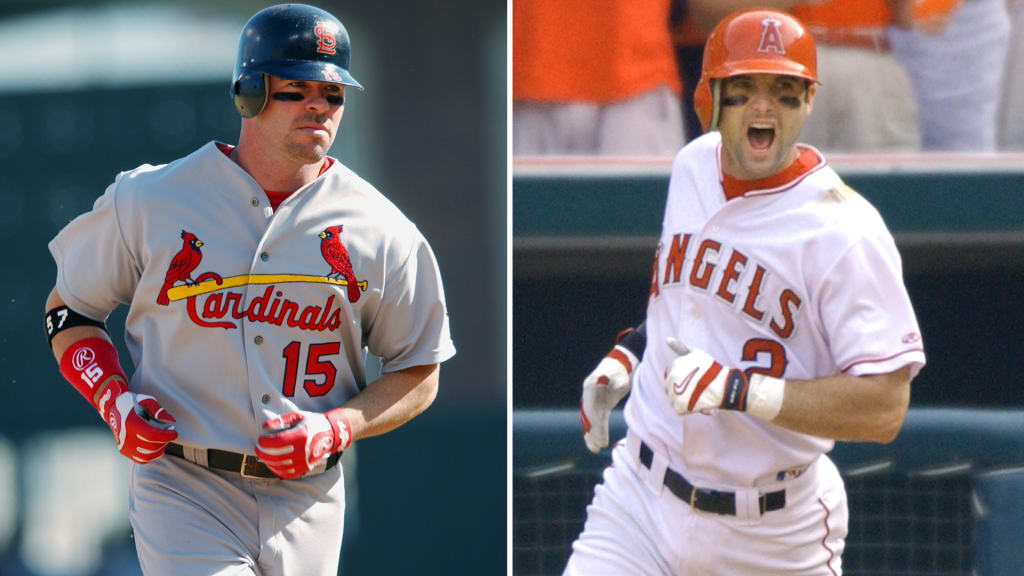
Baseball trades that work out well for both sides might be rarer than you think. Hindsight is 20-20, and we often look back on trades that turned out great for one side and terribly for the other, but in the year 2020, we revisit a deal that bore fruit for both clubs involved.
Monday marks the 20th anniversary of the swap between the Angels and Cardinals that sent center fielder Jim Edmonds to St. Louis in exchange for veteran right-hander Kent Bottenfield and second-base prospect Adam Kennedy. The move preceded World Series titles for both clubs, with the Halos winning their first championship in franchise history in 2002, and the Cards winning their first championship in 24 years four years later.
Let’s look back at the impetus behind the deal and why things turned out the way they did in Anaheim and St. Louis.
Why it happened
Edmonds, who had yet to reach his potential due to injuries but averaged 28 homers per 162 games and won two Gold Glove Awards, had been on the trade market for quite some time. And though general manager Bill Stoneman announced on March 19, 2000, that Edmonds was off the trade block, a deal with the Cardinals came together by March 23.
The Angels desperately needed starting pitching. Anaheim was coming off a season in which the rotation posted a 5.20 ERA. Bottenfield was entering his age-31 season and had just enjoyed a breakout year with St. Louis -- he finished the 1999 campaign with a 3.97 ERA (116 ERA+) over 31 starts, though a 4.75 FIP portended what was to come.
Anaheim also needed an upgrade at second base, where the group competing for the starting job during Spring Training left a lot to be desired. Kennedy, who made his big-league debut the prior August, hit .327/.378/.490 with 10 homers and 20 steals in 91 games for Triple-A Memphis in '99, being named the Cardinals’ Minor League Player of the Year.
The Cardinals, meanwhile, were looking to get back into contention following three years of finishing no higher than third in the National League Central. St. Louis was one game away from the World Series in 1996, but had sputtered thereafter. A young J.D. Drew had patrolled center field for the club in ’99, and the lineup needed an upgrade around slugger Mark McGwire. Enter Edmonds, who offered big upside if he could stay healthy.
Why it worked for the Angels
Bottenfield posted a 5.71 ERA in 21 starts for the Angels in 2000 before he was traded to Philadelphia that July, and was out of baseball by ’02. But Kennedy quickly seized the everyday second base job, and would retain it for the next seven seasons. In 2000, he hit .266/.300/.403 with nine homers and 22 steals in 156 games. By ’02, he was entrenched at second and had his finest season to that point, slashing .312/.345/.449 to help Anaheim reach the postseason via the American League Wild Card. No one could foresee what was to come for Kennedy and the Angels that October.
Kennedy doubled and homered in a pivotal Game 3 of the AL Division Series against the defending World Series-champion Yankees, and then caught fire in the AL Championship Series against the Twins. In the series-clinching Game 5, he launched three home runs, one of the most improbable three-homer games in postseason history -- he hit the first two off Minnesota starter Joe Mays, and the last one off Johan Santana. Overall, Kennedy hit .357 and was named ALCS MVP. In the World Series against the Giants, he went 7-for-25 (.280) with a pair of doubles as the Angels captured their first world championship.
Kennedy spent four more seasons with the Angels before signing with the team that originally drafted him, the Cardinals, in 2007. Ironically, he became teammates with Edmonds, who was in his final year with St. Louis. Kennedy also played for the Athletics, Nationals, Mariners and Dodgers before retiring following the 2012 season.
Why it worked for the Cardinals
The Cardinals took a chance on the oft-injured Edmonds, and it paid off immediately. Edmonds had a career year in 2000, posting a .994 OPS with 42 home runs and another Gold Glove Award in center. He finished fourth in NL MVP voting and helped lead St. Louis to an NL Central title. In the NLDS vs. the Braves, he hit .571 with four doubles and two homers. St. Louis swept Atlanta, and though Edmonds homered again in the NLCS against the Mets, the Cardinals fell to New York in five games.
Edmonds came into his own as a star with St. Louis. At his peak, he put up Hall-of-Fame-caliber numbers -- from 2000-05, he averaged a slash line of .292/.406/.584 (154 OPS+) with 35 home runs a season. He won the NL Gold Glove Award in center field each of those six seasons. The Cardinals also reached the postseason in five of those six years, but were unable to win it all. Despite Edmonds being hurt for much of the regular season, that changed in 2006, when St. Louis defeated the Padres in the NLDS, the Mets in the NLCS and the Tigers in the World Series. Edmonds homered twice in the NLCS and hit .250 (13-for-52) overall that postseason.
That was pretty much the end of Edmonds’ run of prolific production year-in and year-out; he would play three more seasons in the Majors -- one with the Cardinals, one split between the Padres and Cubs, and another split between the Brewers and Reds -- posting a .792 OPS before retiring at age 40 in 2010. But his peak came as a Cardinal, and what a peak it was. He was a big reason why St. Louis was able to break a 24-year championship drought.
The gift that kept on giving
In December 2007, the Cardinals traded a 37-year-old Edmonds to the Padres for a prospect named David Freese. Little did St. Louis know that the hometown Freese would become one of the most iconic players in franchise history for his heroics in October 2011. Freese hit .545 with three doubles and three homers to capture NLCS MVP honors as the Cardinals beat the Brewers to get back to the World Series for the first time since ’06. He then outdid himself in the Fall Classic against the Rangers.
Freese will forever be remembered for his clutch hitting in Game 6, when he came to the plate with two outs in the ninth inning and St. Louis one out away from losing the World Series. Down in the count, 1-2, against Texas flamethrower Neftali Feliz, Freese hit a game-tying triple off the right-field wall. Then in the 11th, he hit a walk-off home run to center field to force a Game 7, which St. Louis won the next night. Overall, Freese hit .348 for the series with three homers, being named World Series MVP.
Freese spent five seasons with the Cardinals in all, slashing .286/.356/.427 (115 OPS+) before being traded to -- who else? -- the Angels for Peter Bourjos and Randal Grichuk following the 2013 season. Looking back, you could draw a line starting from the Cardinals' 2011 championship, through the '06 title and to the trade that took place 20 years ago Monday, when St. Louis acquired Edmonds for Kennedy and Bottenfield.
